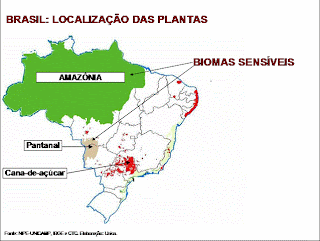The worldwide reaction against rapid expansion of biofuels has continued, with a proposal by the United Kingdom government to slow down the rate at which the country’s transport fuel must increase its renewable content. The announcement follows the publication of an official review which concluded that uncontrolled use of biofuels could drive changes in land use that may increase overall greenhouse gas emissions, as well as push food prices still higher.
While the review praised Brazilian ethanol as amongst the most efficient types of biofuel, it included a case study warning that carbon dioxide emissions from producing the fuel could increase by more than 60% if sugarcane is planted in place of native Cerrado vegetation.
The reverse in British biofuels policy was a response to a report on the indirect effects of biofuels production, carried out by the head of the government’s independent Renewable Fuels Agency, Professor Ed Gallagher. It did not argue for a moratorium on biofuels, as some European NGOs are now demanding, but did say current targets in Britain and the European Union for increasing mandatory biofuel use should be revised. It said continued increases in biofuels content beyond 2013 should only proceed if it could be conclusively proven that the environment and food supply were not being compromised, either directly or indirectly.
The British Transport Secretary, Ruth Kelly, responded immediately to the report by announcing a consultation to change the current “Renewable Transport Fuel Obligation”, which sets the minimum biofuels content that UK fuel suppliers must meet. The proposal is that instead of increasing the biofuel level to 5% by 2010/11, this target should be delayed until 2013/14.
The review was commissioned by the British government as a reaction to growing international concern about the sustainability of rapid biofuels expansion, including the potential impact on the Amazon rainforest and other Brazilian ecosystems. Among the indirect impacts feared are the added pressure from increased Brazilian soya production, as American farmers switch from soya to corn to produce ethanol, and the displacement of cattle to the Amazon basin as former pasture lands in other parts of Brazil are occupied by sugarcane plantations.
The Gallagher review says the issues surrounding these possible indirect impacts are highly complex, and require much more research before they can be accurately assessed. However, it notes (not specifically about Brazil), that “the balance of evidence shows a significant risk that current policies will lead to net greenhouse gas emissions and loss of biodiversity through habitat destruction.
“This includes effects arising from the conversion of grassland for cropland.”
The British review acknowledges that the efficiency of different biofuels production methods varies greatly in terms of their CO2 emission savings, with the Brazilian ethanol system scoring very highly, especially because the waste bagasse from sugarcane plants is used in many mills to produce renewable electricity.
However, one of a series of case studies commissioned for the review warns that this efficiency could be severely compromised if large-scale sugarcane expansion takes place on land currently occupied by native ecosystems, especially in the Cerrado.
The Brazilian case study, carried out by consultant Giúlio Volpi, formerly of WWF, is critical of the government agricultural research body EMBRAPA for claiming that 71 million hectares of the Cerrado is still available for agricultural expansion, without providing information either on the biodiversity status of this land, or on the potential loss of carbon that would take place if it were cultivated.
The report goes on to quote an unpublished study which estimates that conversion of Cerrado soils to sugarcane involves the loss of around 10% of their carbon – assuming the native vegetation contained 25 tonnes of carbon per hectare, this would lead to the emission of 237 grammes of carbon dioxide for each cubic metre of ethanol produced, an increase of 63% on the current average situation.
The case study accepts the argument that the negative impacts of biofuels expansion can be very much reduced if production is concentrated on the large areas of degraded cattle pasture available, especially in former Cerrado regions. Among its policy recommendations are increases in productivity of cattle production, “agro-ecological zoning” to control the location of new sugarcane plantations (due to be announced this month by the Brazilian government), and stricter enforcement of anti-deforestation laws.
In the British government report, Professor Gallagher makes it clear he believes biofuels can potentially still play a significant role in reducing global greenhouse gas emissions. However, his call for a slowdown, and its immediate acceptance by UK ministers, are further evidence of Europe’s growing doubts about the sustainability of what was once seen as a crucial weapon in the fight against climate change.
This article was published in Portuguese on www.oeco.com. Copyright O Eco, All Rights Reserved.







 The clue to the paradox lies in a comment from Brazil's own government statistical office. "The high levels of recycling are more associated with the value of raw materials and the high levels of poverty and unemployment, than with education and environmental consciousness," it acknowledged.
The clue to the paradox lies in a comment from Brazil's own government statistical office. "The high levels of recycling are more associated with the value of raw materials and the high levels of poverty and unemployment, than with education and environmental consciousness," it acknowledged.  Modern system
Modern system

